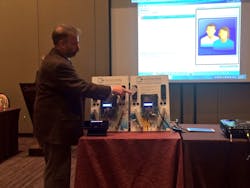PSIA demos PLAI access control specification at ASIS
The Physical Security Interoperability Alliance (PSIA) successfully demonstrated its PLAI specification on Wednesday at ASIS in Dallas.
A panel consisting of RightCrowd’s Darren Bain, chairman of the PSIA PLAI working group; Jason Ouellette of the Software House division of Johnson Controls; John Santini of Princeton Identity and Blaine Fredrick of eyelock demonstrated how the PLAI specification could integrate the users of eyelock and Princeton Identity software with a Software House C-Cure system. “The PLAI agent connects users, identities and badges into the access control management system,” Ouellette explained to a room full of security integrators, adding that it enables a user to take a credential and duplicate it across multiple brands of access control management systems.
PLAI was designed by PSIA for integrators tasked with integrating disparate physical access control systems, as is the case, for example, when one company that uses a certain PACS acquires a second company that uses a different one.
“This spec is a great way to bring all that together,” Bain said in an opening statement.
Bain stressed that the specification is not a product - rather it is a specification for shared identities and credentials. “It helps integrators avoid PACS-specific integrations,” Bain added. “We are building forward to actual adoption - now it’s happening.”
PLAI was introduced in 2015, but according to those on hand, real integrations will be happening in real-world situations within months. In fact, Ouellette indicated that the commercial agent PLAI release will occur in the first quarter of 2018. “It will be publicly addressable for testing purposes,” he said, “This is an important step, so people know the adaptors will work.”
Learn more about PLAI at www.psiaalliance.org.
About the Author
Paul Rothman
Editor-in-Chief/Security Business
Paul Rothman is Editor-in-Chief of Security Business magazine. Email him your comments and questions at [email protected]. Access the current issue, full archives and apply for a free subscription at www.securitybusinessmag.com.

